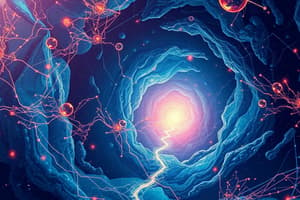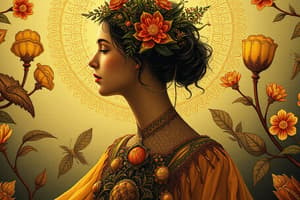Podcast
Questions and Answers
What does the word 'image' refer to?
What does the word 'image' refer to?
- A printed document
- An item that depicts visual perception (correct)
- A type of electronic device
- A fictional character
Which of the following are purposes of real images? (Select all that apply)
Which of the following are purposes of real images? (Select all that apply)
- To persuade (correct)
- To tell fiction stories
- To entertain (correct)
- To inform or educate (correct)
Make-believe images are also known as what?
Make-believe images are also known as what?
- Non-fact images (correct)
- Real images
- Actual images
- Fact images
What is irony?
What is irony?
What is hyperbole?
What is hyperbole?
A figure of speech __________.
A figure of speech __________.
Match the idiomatic expressions with their meanings:
Match the idiomatic expressions with their meanings:
The expression 'hold your tongue' means to __________.
The expression 'hold your tongue' means to __________.
What can you identify in a favorite song?
What can you identify in a favorite song?
Onomatopoeia refers to the repetition of the same initial consonant sounds.
Onomatopoeia refers to the repetition of the same initial consonant sounds.
Identify an example of onomatopoeia.
Identify an example of onomatopoeia.
What is alliteration?
What is alliteration?
What is consonance?
What is consonance?
Figures of sounds are __________.
Figures of sounds are __________.
What should you write in your notebook after identifying your favorite poem?
What should you write in your notebook after identifying your favorite poem?
Flashcards are hidden until you start studying
Study Notes
Types of Images
- Definition: "Image" is derived from the Latin word "imago," referring to visual representations like photographs or illustrations.
- Print Images: Include photographs and images in magazines, newspapers, and books.
- Non-Print Images: Digital representations found on devices like mobile phones, TVs, and computers.
Real Images
- Characteristics: Depict actual objects or events; also referred to as fact images.
- Purposes:
- Inform/Educate: Actual photographs (e.g., wildlife).
- Tell Stories: Used in picture-story books.
- Entertain: Humorous images or stolen photos.
- Persuade: Images like smoker’s burnt lungs to quit smoking.
Make-Believe Images
- Characteristics: Illustrate imaginative concepts that do not exist in reality; known as non-fact images.
- Purposes:
- Entertain: Images of fantasy worlds or magical creatures.
- Tell Fiction Stories: Used in fairy tale picture books.
- Persuade: Editorial cartoons expressing opinions through caricatures.
Figures of Speech
- Irony: Contrast between what is said and what is meant or expected.
- Hyperbole: Exaggerated statements for emphasis.
Idioms
- Definition: Figurative language that cannot be understood from the literal meanings of the individual words.
- Examples:
- "Donkey's years" means a very long time.
- "Fish out of water" describes someone uncomfortable in unfamiliar situations.
- "Smell a rat" indicates detecting something suspicious.
Sound Devices in Poetry
- Onomatopoeia: Words that mimic sounds (e.g., bang, hiss, buzz).
- Alliteration: Repetition of initial consonant sounds (e.g., "frog frolicked").
- Assonance: Repetition of vowel sounds within words (e.g., "Hear the mellow wedding bells").
- Consonance: Repetition of consonant sounds in the middle or end of words (e.g., "He fumbles at your spirit").
Analyzing Poems
- For the poem "Running Water" by Lee Emmett, identify examples of:
- Onomatopoeia: "water plops," "splish-splash."
- Alliteration: "warbling magpies."
- Assonance: "trilling, melodic thrill."
- Consonance: "flags flutter and flap."
Reflection
- Encourages students to create personal connections with poetry through imagery and to explore both real and make-believe components.
- Promote critical thinking by discussing favorite poems and personal beliefs.
Task Activities
- Identify and box idiomatic expressions in sentences.
- Create real and make-believe images related to a favorite poem.
- Work in notebooks to classify and analyze figurative language and sound devices used in poetry.
Studying That Suits You
Use AI to generate personalized quizzes and flashcards to suit your learning preferences.




